| What follows is taken from the Official Handbook
published by Bilston Borough Council at the end of the
1950s. It covers the amenities that were under the
control of the council along with health, education,
religion, public transport and industry.
In the late 1950s, Bilston was a thriving industrial
borough with an expanding population.
population:
1801 - 5,600: 1811 - 9,640:
1832 - 14,492: 1852 - 24,000:
1923 - 28,000: 1930 - 31,160:
1947 - 31,970: 1951 - 33,464:
1953 - 33,420: 1957 - 33,960.
By this time the pre-war slum areas had been
redeveloped, nearly 200 acres of land had been reclaimed
for the building of houses and playing fields, along
with 36 acres for the Loxdale Industrial Estate.
There were many good schools for children, employment
was plentiful, the market and the local shops were
thriving, and there was plenty of night life. The
library and museum were extended and health care was
well catered for by the Central Health Clinic.
It was almost a golden era, which in modern times has
changed considerably. |
 |
|
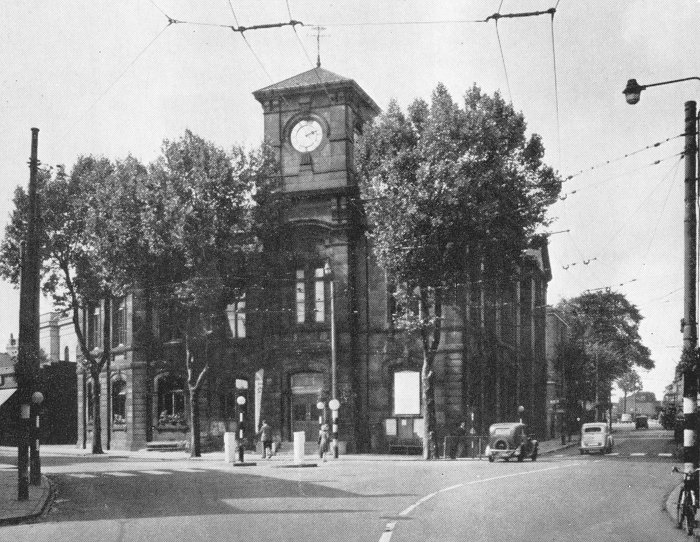
Bilston Town Hall. |
|
Chief Council Officers and
Departmental Heads:
Town Clerk - A. M. Williams
Borough Treasurer - H. E. Carder
Medical Officer of Health - J. P. Neylon
Borough Engineer - A. F. B. Sidwick
Housing Director - C. R. Lawley
Chief Public Health Inspector - J. R. Tart
Housing Manager - A. Scott
Borough Librarian - H. G. Wood
A strong community spirit binds
Bilston people together in their play as in their work.
The Council is actively interested in housing
conditions, the provision of sport and outdoor
recreation facilities and also indoor amusement and
social and cultural amenities in general. There are many
organisations and societies in the Borough besides clubs
and institutions for people of all ages as well as a
number of cinemas which will be mentioned later.
During the last ten years or so the
Council has gone ahead with building as speedily as
possible even though it has been necessary to carry out
large land reclamation works involving the removal of
over a million tons of earth works. By the 31st October,
1947, the Council had completed 63 permanent houses and
private enterprise another 16. At the same time 24
families were temporarily re-housed in converted
premises. These figures compare favourably with those of
1919/20, for in 1919 the Council erected only 27
temporary houses and 30 in 1920, whilst permanent
houses, including 2 built by private enterprise,
totalled only 19 for those two years. The Council's
5,000th house was opened in 1957.
Special consideration has been
given to the provision of accommodation for aged persons
and bungalows have been erected at Ormond Place, Beckett
Street the Rough Hills Estate and in the Temple Street
redevelopment area. Shopping Centres have been
established on all the Housing Estates and in addition
the Council have constructed numerous lock-up garages on
the various Estates.
Dwellings built in post-war years
consist of houses of 1-6 bedrooms. Considerable
variation has been provided in the types of houses
erected which gives interest in the appearance of the
estates. On Bradley Lane South a special feature has
been the 2-storey flats. The 100 temporary houses "Arcon"
type with two bedrooms, in Great Bridge Road, which for
10 years provided good accommodation for the tenants,
have been demolished and the site redeveloped with the
construction of 154 modern traditional type houses,
flats and bungalows.
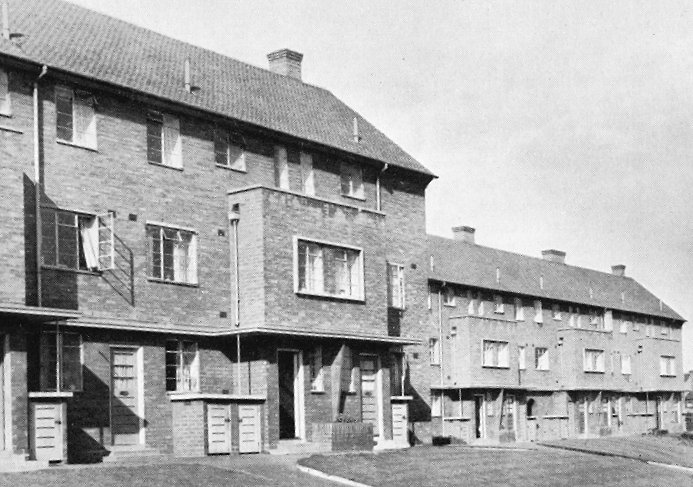
New houses in Ward Street.
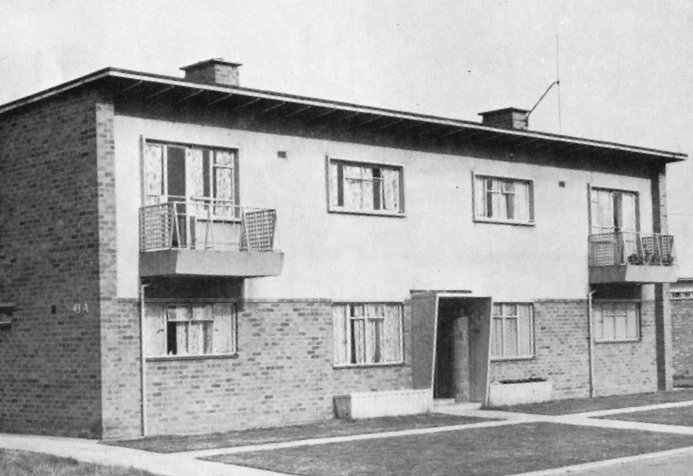
Stow Lawn Estate. |
|
Health Service
Bilston Council, prior to
regionalisation of the health services, was responsible
for the Mountford Lane Infectious Diseases Hospital.
Hospital services are provided by the Royal Hospital,
Wolverhampton; Wolverhampton and District Hospital for
Women; and the Wolverhampton Eye Infirmary, all easily
and quickly accessible from Bilston.
Bilston is fortunate in having
health services for Maternity and Child Welfare and the
County School Medical Services housed in the Centre
Health Clinic. This modern building at the corner of
Wellington Road and Prouds Lane was opened in February,
1940, by the Countess of Harrowby. Its initial cost was
£16,000 and the excellent accommodation provided has
greatly increased the efficiency of the services
provided.
Infant Welfare Centres under the
control of Staffordshire County Council are held each
week on Monday and Thursday afternoons from 2-4 pm. at
the Centre Health Clinic. Weekly attendances average
130. A fortnightly session is held at John Street,
Ettingshall, on 1st and 3rd Tuesday afternoons from 2-4
pm. Ante-Natal Clinics are conducted here on Fridays at
9 am. and 1.30 pm. by Dr. J. A. Nagle. Average
attendance is 28 mothers.
Eye Clinic: Mr. Campbell Orr
interviews all mothers referred from the Welfare and
Ante-Natal Clinics and babies and toddlers referred from
the Welfare Centres at a special session held on
Wednesday mornings. Diphtheria Immunisation: Children
under school age may be immunised at the Infant Welfare
Centres. Others are immunised by the School Medical
Officer. Dental Clinics for ante-natal and nursing
mothers and toddlers are arranged with the Dental
Surgeon who attends daily. The average number of
patients per session is ten. Minor Ailments Clinics are
held each weekday from 9 am. to 12 noon. Eye Clinics:
Mr. Campbell Orr is in attendance every Wednesday from 9
am. to 1 pm. Dental Clinics are held at 9.45 am. and
1.45 pm.
An ambulance service is operated by
Staffordshire County Council from a main station at
Richards Street, Darlaston, where a day and night
service of both ambulance and sitting cars is provided.
The Day Nursery in Prouds Lane (for
10 babies and 20 toddlers), formerly provided by Bilston
Council, is now controlled by Staffordshire County
Council and is open Mondays to Fridays between 7.45 am.
and 6.30 pm.
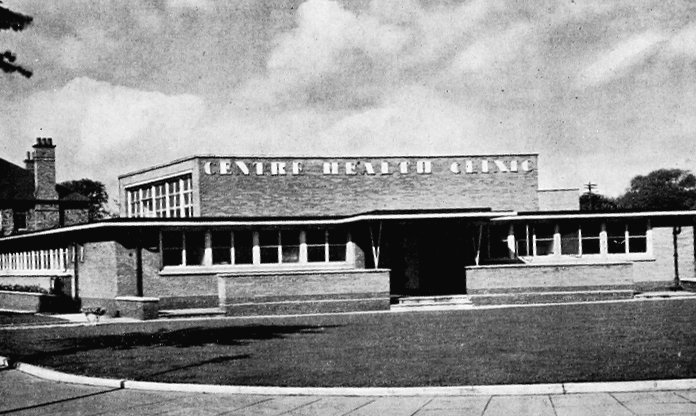
The Centre Health Clinic. |
|
Education Facilities are provided
in Bilston for primary and secondary modern education at
18 schools including four Church of England Schools and
one Roman Catholic School. In Wellington Road is to be
found the handsome brick-built Girls' High School set in
well-planned grounds where secondary grammar school
education is provided for girls. Similar facilities are
available for boys at the Bilston Boys' Grammar School.
The Bilston College of Further
Education was established in 1947 and was one of the
first of such Colleges to be established under the 1944
Education Act. It has developed rapidly and has an
annual enrolment of about 2,000 with an anticipated rise
in this figure to some 5,000 when fully developed. It
serves an area wider than Bilston and offers, as may
well be expected in such an area, a wide variety of
vocational and non-vocational courses. It is at present
housed in buildings which were erected by public
subscription in 1896 so that the present College is,
historically speaking, a rapid expansion of educational
activity which has been going on for the last sixty
years. A new College is now being built on a fine open
site at Stowlawn, the Engineering block being already in
use. The College is well known for the contribution it
is making to the creation of an efficient and adequate
instrument of further education, as envisaged in the
Education Act, and is already a considerable influence
in the cultural life of the area.
Staffordshire County Council also
maintains an occupational centre for mentally defective
children and in Coseley Road is the Youth Employment
Bureau, where advice and help is given with a view to
placing intending school-leavers in suitable employment.
Libraries
In 1935, the Council purchased
Brueton House, Mount Pleasant, which was enlarged and
adapted for use as a public library and reading room.
Extensions were also made for a museum and art gallery.
The new buildings, fronted by trees and gardens, which
were opened on the 18th March, 1937, provide for both
adult and junior libraries, together with reference and
reading rooms. All residents in Bilston have the free
use of the books provided, which total about 35,000
volumes. The subscription rate for non-residents is 5
shillings a year, but anyone holding a valid ticket of
any other library may have free use of the library. The
library is open weekdays from 10 am. to 7 pm. except
Wednesdays and Saturdays when it closes at 5 pm.
Approximately 5,000 books are
available in the junior library which is open from 4 pm.
to 6 pm. Monday to Friday (except Wednesday when it is
closed at 5 pm.), and on Saturday from 10 am. to 1 pm.
and 4 pm. to 5 pm. It is open mornings during school
vacation periods.
The reference library, which is
open concurrently with the lending library has been
developed and includes facilities for obtaining quickly
information on numerous subjects. There is also a local
collection relating to Bilston and Staffordshire which
contains books, maps, pamphlets and other printed
materials, as well as photographs and manuscripts, and
this also links up with the museum and art gallery. Five
galleries grouped around the central staircase afford
1,852 square feet of floor space for museum exhibits.
Local bygones and the more interesting and artistic
examples of local history, including Bilston enamels,
japanned ware and pottery, are special features of the
permanent exhibition and there is also a collection of
local birds. Hours of opening: weekdays, May to
September, 10 am. to 7 pm.; October to April, 10 am. to
5.0 pm. Closed on Sundays.

The library, museum and art
gallery.
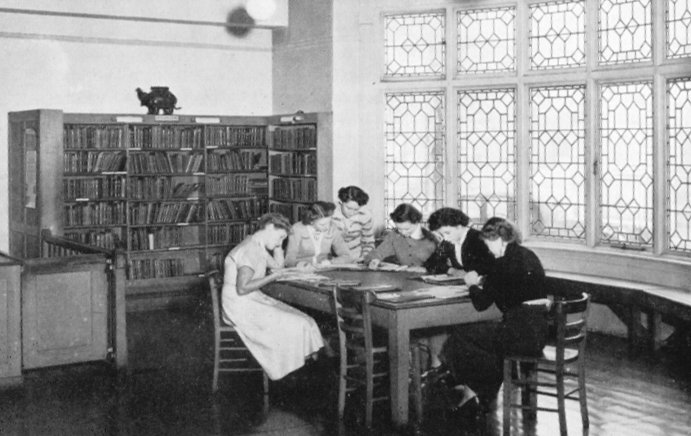
A reading room in the library,
museum and art gallery.
Parks and open spaces already
provided in the borough cover approximately 100 acres
and in their plans for the immediate increase in
facilities for outdoor recreation the Council propose to
increase this acreage to 220 acres. Excellent
recreational facilities are provided at Hickman Park,
opened 1911, where twelve acres of well-timbered grounds
are laid out with lawns, flower beds, rose garden and
bandstand, and facilities are also provided for tennis
and sport.
The four and a half acres of
Greenway Playing Fields at Bradley, and £2,000 for their
upkeep, were gifts to the borough in 1931 by Mr. James
Luther Greenway, J.P., who also contributed £1,000
towards laying-out municipal playing fields in Trinity
Road, which were opened in 1938, and placed £3,000 on
trust in the interest of convalescent children and for
Christmas and summer treats for children of the Bradley
Ward.
There are also public open spaces
at Prouds Lane and Stowlawn. In 1948, eighteen acres of
land in Great Bridge Road was acquired to provide
playing field facilities in the town. The site is laid
out to provide three cricket and four football pitches,
two tennis courts and a netball pitch.
The Council is also a Burial
Authority owning a cemetery, which was opened in 1855,
of about fourteen acres in Cemetery Road, off Wellington
Road.
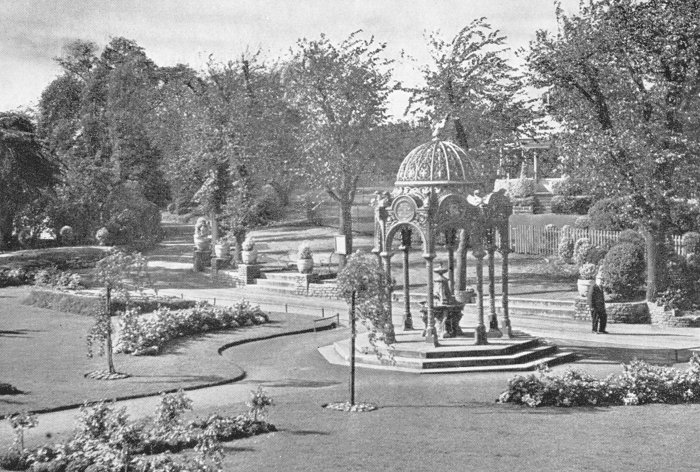
Hickman Park. |
| The Market Hall fronting High Street was erected
in 1891 and contains 85 shops and stalls, a further
49 stalls being provided in the adjoining open
market. Market rights and premises are owned by the
Corporation, the public market being established by
Act of Parliament in 1824. Major structural
improvements including electric lighting
installations have been carried out in recent years.
Bilston's water supply is owned and controlled by
the Corporation and comes mainly from the Bratch
Waterworks, Wombourne. These works were built
between 1892-97 and extended in 1924-27. Bilston
offers to industrialists and residents alike the
exceptional advantage of gas at attractive rates,
and details of the Board's all purpose tariff are
available at the District Office in Ward Street,
Ettingshall, and at the Sales and Service Centre, 17
Lichfield Street, Bilston. Electricity in the
Borough of Bilston is provided by the Midlands
Electricity Board whose District Offices are at Camp
Street, Wednesbury. Attached to these offices and,
at 55 Church Street, Bilston, are Service Centres
where all types of electrical appliances can be
inspected and well trained staff are available to
give free advice on the economical use of
electricity in the home. |
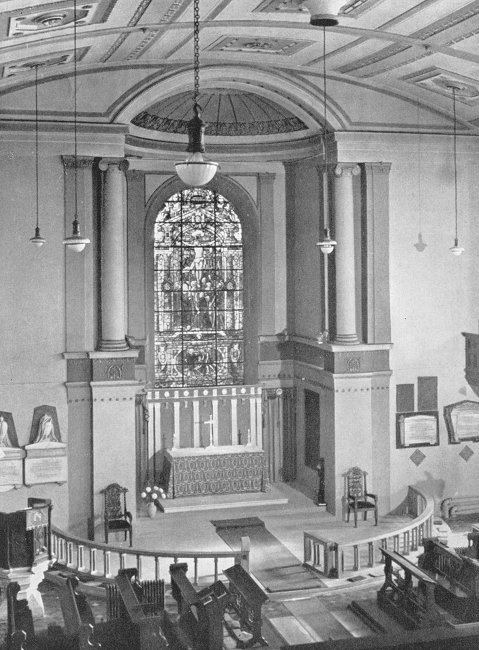
St. Leonard's Church. |
|
Two south-west rail routes run
through the town from the adjoining important rail
centre of Wolverhampton. The Ettingshall and Bilston
Station, situated in Parkfield Road, serves one which
continues as the Stour Valley line to Dudley and
Birmingham (New Street) whilst the other route forks at
Priestfield Station (John Street) via Coseley and
Bradley Stations to Oxford and Worcester and via Bilston
Central Station (Railway Drive) to Dudley and Birmingham
(Snow Hill)
The Wolverhampton Corporation
Trolley buses link up the adjoining towns and districts
of Coseley, Darlaston, Sedgley, Willenhall and Walsall,
whilst connections can easily be made with the Midland
Red Omnibus network which serves Wolverhampton, Dudley
and the outlying countryside. |
|
Industry
Joseph Sankey & Sons Limited,
founded 100 years ago in Bilston by the grandfather of
the present Chairman and Managing Director, began by
making and japanning tea trays. The business prospered
and increased its range to embrace many kinds of
hollow-ware and by 1874, when John William Sankey, the
eldest son of the founder, was in the business, the
number employed had risen to 65.
About 1886 it was becoming evident
that armatures for dynamos would in future be made from
charcoal sheet iron and early in 1887, Sankeys booked
their first order for stampings of this nature. This was
the beginning of the electrical lamination business. The
rapid growth of electric lamination production and
improvement in electrical qualities of steels
necessitated the establishment of a new factory at
Bankfield in 1900 and the purchase of Manor Sheet
Rolling Mills in 1904.
Today Bankfield Works are the
largest and best equipped in Europe for the production
of laminations for the electrical and allied industries.
Steel body panels for the Arrol-Johnson car and the
first pressed steel artillery wheel followed in 1909.
Demand for this latter product was so great that in 1910
it was necessary to acquire the Castle Works, Hadley,
Shropshire, and the production of motor car bodies was
also switched to the new factory. These works have been
vastly extended and turn out enormous quantities of
wheels, motor car chassis and pressings for the
shipbuilding, engineering, aircraft and building
industries. The famous Sankey-Sheldon office furniture
and steel partitions are also made at Hadley and there
are in addition large departments engaged in the
production of agricultural machinery, trailers, washing
machines, etc. |
 |
In 1929, increased demands for
the Company's products necessitated the purchase of
Bath Street Works, Bilston, which produce components
for jet aircraft engines and large pressings of all
types. Indeed, much of the pioneer work in
connection with the fabrication of jet engine
combustion chambers was carried out at Albert Street
many years before jet aircraft flew.
Since 1943, five overseas
factories have been established, two in India and
one in Australia for electrical laminations; one in
Canada for steel furniture and one in South Africa
for both steel furniture and laminations.
To cope with the ever-growing
expansion of the organisation, smaller satellite
factories have been established at Hereford,
Stourport-on-Severn, Dudley and Cannock.
Since its foundation a century
ago by Joseph Sankey and two fellow workmen, the
company has now come to employ many thousands of
people at home and abroad and is a member of the
Guest, Keen and Nettlefolds Group, but it is
significant that during the whole period members of
the Sankey family have, in unbroken succession, held
executive positions in the organisation. |
|
Stewarts and Lloyds Limited.
Bilston Works has been the site
of blast furnaces at least since the 1780's. By 1882
Springvale Furnaces Ltd. were not only making iron
there but had installed ball furnaces, puddling
furnaces and a considerable variety of mills. In
that year a big step forward was taken when the
Staffordshire Steel and Ingot Iron Company Limited
was formed with a capital of £70,000 for the purpose
of manufacturing by the Thomas Gilchrist process. In
order to get the process going, the plant of the
Mersey Iron and Steel Works was purchased in 1883
and re-erected, with adaptations, at Bilston. This
continued in operation until the 1920's.
In 1897 Springvale Furnaces
Limited, and the Staffordshire Steel and Ingot Iron
Company were amalgamated under the title of Alfred
Hickman Limited and the works came to be considered
as a unit rather than as two companies on the same
site.
Many new installations and
improvements in design were carried out over the
ensuing years, including a Siemens open hearth plant
which eventually replaced the Thomas plant.
In 1920 Stewarts and Lloyds
acquired Alfred Hickman Limited and the works saw
many further additions and improvements, such as a
Morgan continuous strip mill, which began operation
in 1923, and has been recently demolished.
At the end of the war the works
consisted of three blast furnaces of a fairly old
design capable of producing about 200,000 tons of
pig iron per annum, and an open hearth plant of five
furnaces with an annual output of about 250,000 tons
of steel per annum. The works also included a
cogging mill and a bar mill where round and square
sections were rolled for tube manufacture. |
|
During the early 1950s the
company undertook further modernisation of the plant
including the installation of a modern blast furnace
capable of producing 200,000 tons of pig iron per
annum, and the raw materials handling site of the
melting shop was improved whereby steel output has
been raised to nearly 350,000 tons per annum.
Today, with a payroll of about
2,800, Bilston Works has two blast furnaces in
operation (one modern furnace and one of the
remaining older furnaces, giving an annual pig iron
output of 280,000 tons) and five open hearth
furnaces with an output of 350,000 tons per annum.
There have been no changes in the rolling mill
installation.
The company is now embarking on
a large new scheme of development for the works
which, by the installation of additional open hearth
furnaces, will increase the steel production to
550,000 tons per annum. Complementary to this will
be a new cogging mill and bar mill of modern design
which will be able to deal with the increased output
from the melting shop. Along with Corby and
Clydesdale Works, Bilston Works forms part of the
great trio of raw material producers for S. & L.
tubes. Incidentally, the four blast furnaces at
Corby were built by Ernest N. Wright Limited,
Millfields Foundry, which became a subsidiary of
Stewarts and Lloyds. |
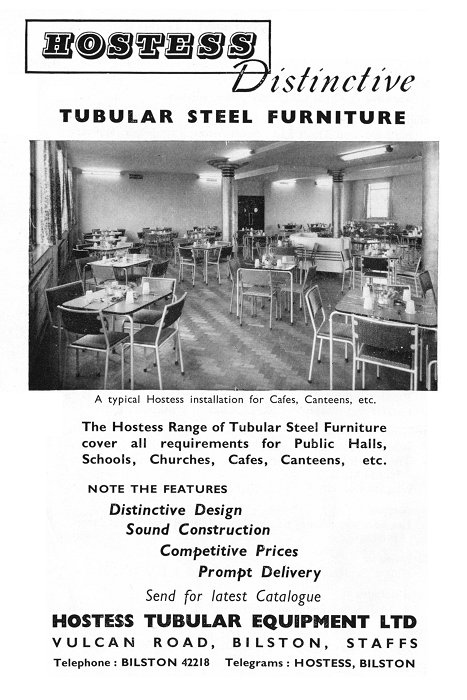 |
|
Farmer & Chapman Limited is one
of the oldest firms in Bilston, having been
established in 1820 as manufacturers of japanned and
tinned goods in Caledonia Street, extending in 1890
to the present address in Prouds Lane.
The firm's activities lie now
in three directions: The manufacture of high class
enamelled and tinned holloware under the trade mark
of Thistle Brand which is supplied to distributors
mainly to the catering, hospital, butchery and
florists' trades, and covers a fairly wide range to
suit their various requirements.
The production of component parts for other
manufacturers, and among these are parts for
cookers, wash boilers, heaters, washing machines,
sanitary appliances. Grill pans of many types are
the firms speciality.
Considerable vitreous enamelling for the trade is
done, and stampings and sheet metal work complete
the range.
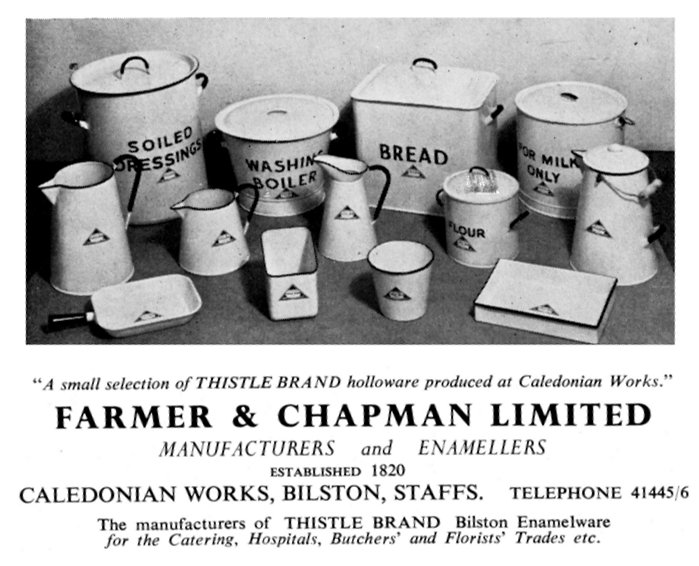 |
| Bradley & Company Limited. Beldray has been a
famous household name since 1872 and although, in the
past, it has been associated only with hollow-ware, the
company now produces a range of modern house wares which
includes the famous Beldray sit-or-stand ironing tables
which have been received so enthusiastically in America
as well as in this country, and the Beldray adjustable
table with adjustable legs to prevent rocking on uneven
floors.
The range of Beldray housewares is being constantly
extended to provide more comfortable living in the
modern homes.
Recent additions include a television trolley with a
swivel top which permits the picture to be turned to
face any part of the room, and the Beldray ‘Ironsto’
which solves the long-standing domestic problem of where
to store your hot iron when you have finished using it.
Beldray hollow-ware and housewares are obtainable
from good ironmongers and department stores throughout
the country The company also manufactures metal
presswork of all kinds. |
 |
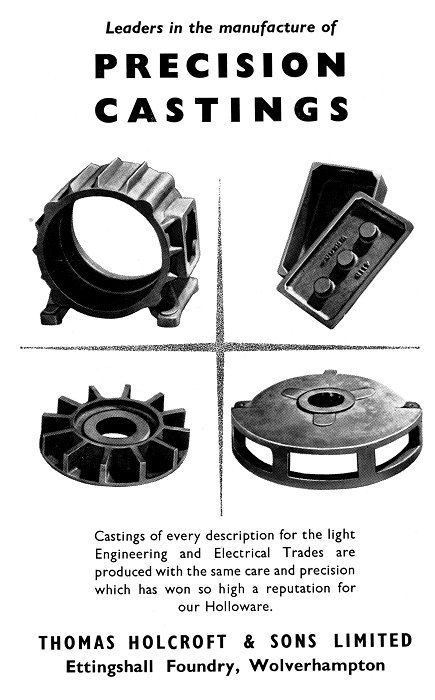 |
Thomas Holcroft & Sons Limited, one of the
pioneers in the cast iron holloware trade, moved
from Bilston towards the end of the last century and
established Ettingshall Foundry at Wolverhampton.
Here the range of products was extended to meet new
demands.
When cooking by electricity was introduced the
company developed and patented their recessed,
machined base utensils which are now specified by
the makers of the famous Aga and Esse cookers.
Cast iron holloware, both tinned and enamelled,
is exported to all quarters of the globe-to such
places as Tierra-del-Fuego and Pitcairn Island, and
even Antarctica may be included, for the most recent
expeditions took Holcroft holloware in their
equipment.
Castings in iron and brass for the building and
plumbing trades. The renowned 'Capital' range were
later produced and this was followed by a further
successful development in machine-moulded castings
for the light engineering and electrical trades.
These range from a few ounces to a
hundred-weight. The Ettingshall Foundry now covers
seven acres and includes wood and metal pattern
shops, machine shops and plant for light pressings,
bower barffing and non-ferrous founding. The
Holcroft slogan ‘From print to the product’ is
indeed well founded'. |
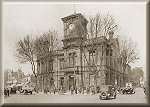
|
Return to
the
Bilston menu |
|